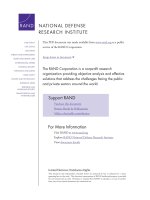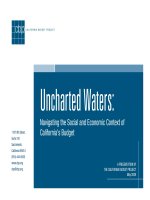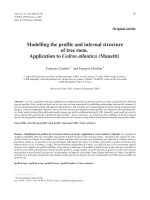the risk and term structure of interest rates
Bạn đang xem bản rút gọn của tài liệu. Xem và tải ngay bản đầy đủ của tài liệu tại đây (469.46 KB, 28 trang )
Copyright 2011
Pearson Canada Inc.
6 -
1
Chapter 6
The Risk and Term Structure of
Interest Rates
Copyright 2011
Pearson Canada Inc.
6 -
2
Risk and Term Structure of Interest Rates
•
The risk structure of interest rates looks at
bonds with the same term to maturity and
different interest rates.
•
The term structure of interest rates looks at
the relationship among interest rates on bonds
with different terms to maturity.
Copyright 2011
Pearson Canada Inc.
6 -
3
Default Risk
•
Default risk - occurs when the issuer of the
bond is unable or unwilling to make interest
payments or pay off the face value
–
Canadian government bonds are considered
default free.
•
Risk premium - the spread between the
interest rates on bonds with default risk and
bonds without default risk
Copyright 2011
Pearson Canada Inc.
6 -
4
Response to an Increase in Default Risk on
Corporate Bonds
Copyright 2011
Pearson Canada Inc.
6 -
5
Credit Ratings Agencies
Copyright 2011
Pearson Canada Inc.
6 -
6
Corporate-Canada Bond Spread 1978 - 2005
Copyright 2011
Pearson Canada Inc.
6 -
7
Other Factors influencing the Risk Structure
•
Liquidity – how quickly and cheaply a bond can
be converted to cash
•
Income tax considerations – in some countries
certain government bonds are not taxable.
–
In Canada coupon payments on fixed-income
securities are taxed as ordinary income.
–
In the U.S. interest payments on municipal bonds
are exempt from federal income tax
Copyright 2011
Pearson Canada Inc.
6 -
8
Term Structure of Interest Rates
•
Bonds with identical risk, liquidity, and tax
characteristics may have different interest rates
because the time remaining to maturity is different.
•
Yield curve - a plot of the yield on bonds with
differing terms to maturity but the same risk,
liquidity and tax considerations
–
Upward-sloping long-term rates are above
short-term rates
–
Flat short- and long-term rates are the same
–
Inverted long-term rates are below short-term rates
Copyright 2011
Pearson Canada Inc.
6 -
9
Empirical Facts To Be Explained by the Term
Structure
1. Interest rates on bonds of different
maturities move together over time.
2. When short-term interest rates are low, yield
curves are more likely to have an upward
slope; when short-term rates are high, yield
curves are more likely to slope downward
and be inverted.
3. Yield curves almost always slope upward.
Copyright 2011
Pearson Canada Inc.
6 -
10
Three Theories to Explain the Three Facts
1. Expectations theory explains the first two
facts but not the third.
2. Segmented markets theory explains fact
three but not the first two.
3. Liquidity premium theory combines the two
theories to explain all three facts.
Copyright 2011
Pearson Canada Inc.
6 -
11
Term Structure of Interest Rates – Fact 1
Copyright 2011
Pearson Canada Inc.
6 -
12
Expectations Theory
•
The interest rate on a long-term bond will equal an
average of the short-term interest rates that people
expect to occur over the life of the long-term bond.
•
Buyers of bonds do not prefer bonds of one maturity
over another; they will not hold any quantity of a bond if
its expected return is less than that of another bond
with a different maturity.
•
Bonds like these are said to be perfect substitutes.
Copyright 2011
Pearson Canada Inc.
6 -
13
Expectations Theory—Example
•
Let the current rate on one-year bond be 6%.
•
You expect the interest rate on a one-year
bond to be 8% next year.
•
Then the expected return for buying two one-
year bonds averages (6% + 8%)/2 = 7%.
•
The interest rate on a two-year bond must be
7% for you to be willing to purchase it.
Copyright 2011
Pearson Canada Inc.
6 -
14
Expectations Theory—In General I
For an investment of $1
i
t
= today’s interest rate on a one-period bond
i
e
t+1
= interest rate on a one-period bond
expected for next period
i
2t
= today’s interest rate on the two-period bond
Copyright 2011
Pearson Canada Inc.
6 -
15
Expectations Theory—In General II
Expected return over the two periods from investing
$1 in the two-period bond and holding it for the two
periods
2t
2
2t
2
22
2
22
22
2i is perids two for period-two the holding for
return expected the small very is )(i Since
)(2
1)(21
1)1)(1(
tt
tt
tt
ii
ii
ii
+=
−++=
−++
Copyright 2011
Pearson Canada Inc.
6 -
16
Expectations Theory—In General III
e
t
e
tt
e
tt
e
tt
e
tt
e
tt
e
t
i
ii
iiii
iiii
i
1t
1
11
11
1t
i
get we gSimplifyin
small extremely is )(
)(
1)(1
1)1)(i(1
investment $1 the with bought are bonds period-one twoIf
+
+
++
++
+
+
++
−+++=
−++
Copyright 2011
Pearson Canada Inc.
6 -
17
Expectations Theory—In General IV
Both bond will be held only if the expected returns are equal.
2
2
1
2
12
e
tt
t
e
ttt
ii
i
iii
+
+
+
=
+=
The two-period rate must equal the average of the two one-
period rates. For bonds with longer maturities:
n
iiii
i
e
nt
e
t
e
tt
nt
)1(21
−+++
++++
=
The n-period interest rate equals the average of the one-period
interest rates expected to occur over the n-period life of the
bond
Copyright 2011
Pearson Canada Inc.
6 -
18
Expectations Theory
•
Explains why the term structure of interest rates
changes at different times.
•
Explains why interest rates on bonds with different
maturities move together over time (fact 1).
•
Explains why yield curves tend to slope up when short-
term rates are low and slope down when short-term
rates are high (fact 2).
•
Cannot explain why yield curves usually slope upward
(fact 3).
Copyright 2011
Pearson Canada Inc.
6 -
19
Segmented Markets Theory
•
Bonds of different maturities are not substitutes.
•
The interest rate for each bond with a different maturity
is determined by the demand for and supply of that
bond.
•
Investors have preferences for bonds of one maturity
over another.
•
If investors have short desired holding periods and
generally prefer bonds with shorter maturities that have
less interest-rate risk, then this explains why yield curves
usually slope upward (fact 3).
Copyright 2011
Pearson Canada Inc.
6 -
20
Liquidity Premium & Preferred Habitat Theories
•
The interest rate on a long-term bond will
equal an average of short-term interest rates
expected to occur over the life of the long-
term bond plus a liquidity premium that
responds to supply and demand conditions for
that bond.
•
Bonds of different maturities are substitutes
but not perfect substitutes.
Copyright 2011
Pearson Canada Inc.
6 -
21
Liquidity Premium Theory
nt
e
nt
e
t
e
tt
nt
l
n
iiii
i +
++++
=
−+++ )1(21
where l
nt
is the liquidity premium for the n-period
bond at time t
l
nt
is always positive and increases with the term to
maturity
Copyright 2011
Pearson Canada Inc.
6 -
22
Preferred Habitat Theory
•
Investors have a preference for bonds of one
maturity over another.
•
They will be willing to buy bonds of different
maturities only if they earn a somewhat higher
expected return.
•
Investors are likely to prefer short-term bonds
over longer-term bonds.
Copyright 2011
Pearson Canada Inc.
6 -
23
The Relationship Between Theories
Copyright 2011
Pearson Canada Inc.
6 -
24
Liquidity Premium & Preferred Habitat Theories II
•
Interest rates on different maturity bonds move together
over time; explained by the first term in
the equation.
•
Yield curves tend to slope upward when short-term rates
are low and to be inverted when short-term rates are
high; explained by the liquidity premium term in the first
case and by a low expected average in the second case.
•
Yield curves typically slope upward; explained
by a larger liquidity premium as the term to
maturity lengthens.
Copyright 2011
Pearson Canada Inc.
6 -
25
Predictive Power of the Yield Curve
•
Can use theories to make predictions about short-
term rates.
•
Steeply rising yield curve short term rates are
expected to rise
•
Moderately steep yield curve short-term rates are
not expected to rise or fall substantially in the future
•
A flat yield curve short-term rates are expected to
fall moderately in the future.
•
Inverted yield curve short-term rates are expected
to fall sharply in the future.









